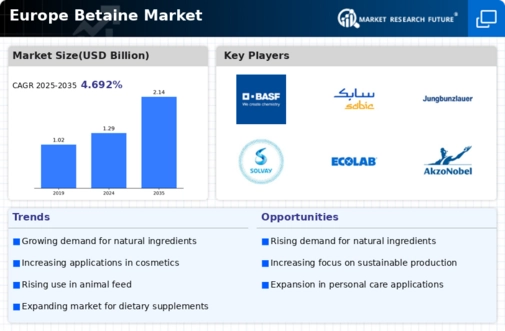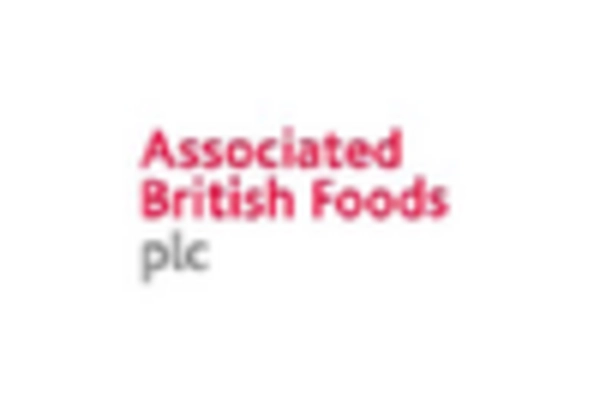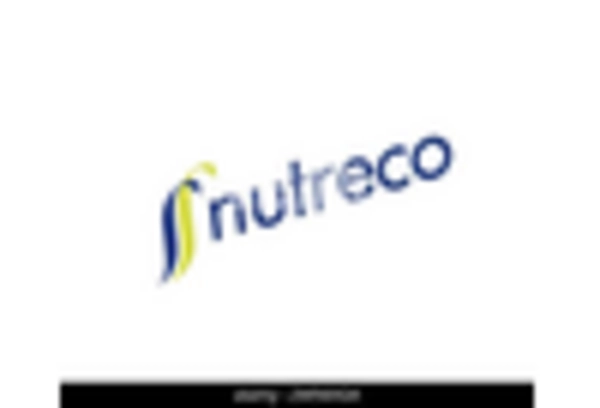Expansion of Nutraceuticals
The expansion of the nutraceuticals sector in Europe is significantly influencing the betaine market. Nutraceuticals, which bridge the gap between food and pharmaceuticals, are gaining traction as consumers seek products that provide health benefits beyond basic nutrition. Betaine, recognized for its potential to support liver function and improve metabolic health, is increasingly included in nutraceutical formulations. The market for nutraceuticals in Europe is expected to reach €200 billion by 2027, with betaine playing a crucial role in this growth. This trend indicates a shift towards preventive healthcare, where consumers are more inclined to invest in products that enhance their health. Consequently, the betaine market is likely to experience increased demand as manufacturers innovate and develop new nutraceutical products featuring betaine.
Increasing Health Awareness
The growing awareness of health and wellness among consumers in Europe is driving the betaine market. As individuals become more conscious of their dietary choices, there is a notable shift towards functional ingredients that offer health benefits. Betaine, known for its role in promoting cardiovascular health and enhancing athletic performance, is increasingly sought after. The European market for betaine is projected to witness a growth rate of approximately 6% annually, reflecting the rising demand for health-oriented products. This trend is particularly evident in the food and beverage sector, where manufacturers are incorporating betaine into formulations to appeal to health-conscious consumers. The betaine market is thus positioned to benefit from this heightened focus on health, as consumers actively seek products that contribute to their overall well-being.
Rising Popularity of Sports Nutrition
The rising popularity of sports nutrition in Europe is a key driver for the betaine market. As fitness and athleticism gain prominence, there is a growing demand for supplements that enhance performance and recovery. Betaine is recognized for its potential to improve exercise performance and reduce fatigue, making it a valuable ingredient in sports nutrition products. The sports nutrition market in Europe is projected to grow at a CAGR of 8% over the next five years, indicating a robust demand for effective performance-enhancing ingredients. This trend is likely to encourage manufacturers to incorporate betaine into their formulations, thereby expanding the betaine market. As athletes and fitness enthusiasts increasingly seek products that support their training regimens, the relevance of betaine in this sector is expected to rise.
Technological Advancements in Production
Technological advancements in the production of betaine are shaping the market landscape in Europe. Innovations in extraction and synthesis methods are enhancing the efficiency and cost-effectiveness of betaine production. This is particularly relevant as the demand for high-quality betaine continues to rise across various applications, including food, beverages, and cosmetics. The betaine market is likely to benefit from these advancements, as they enable manufacturers to produce betaine at scale while maintaining quality standards. Furthermore, improved production techniques may lead to a reduction in prices, making betaine more accessible to a broader range of consumers. As technology continues to evolve, the potential for new applications and formulations incorporating betaine is expected to expand, further driving market growth.
Regulatory Support for Functional Ingredients
Regulatory support for functional ingredients in Europe is fostering growth in the betaine market. The European Food Safety Authority (EFSA) has recognized the health benefits associated with betaine, which has led to increased consumer confidence in its use. This regulatory backing is crucial as it encourages manufacturers to incorporate betaine into their products, knowing that it meets safety and efficacy standards. The betaine market is likely to see a surge in product launches that highlight the functional benefits of betaine, particularly in health foods and dietary supplements. As regulations continue to evolve, the clarity and support provided by regulatory bodies may further enhance the market landscape, allowing for greater innovation and consumer acceptance of betaine-containing products.

















Leave a Comment